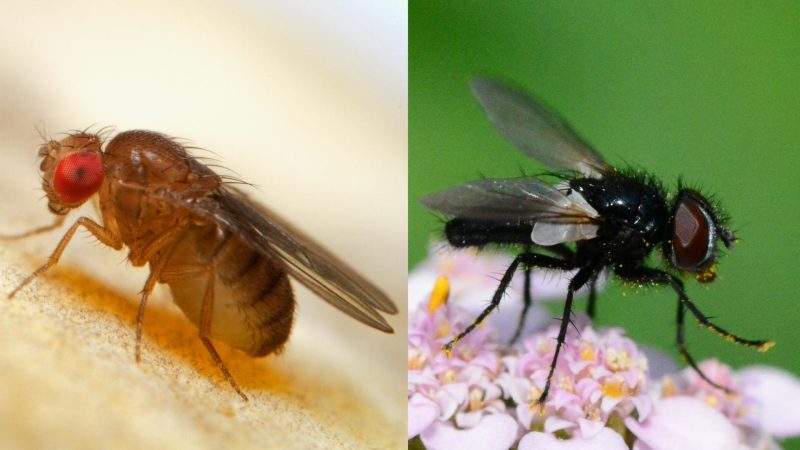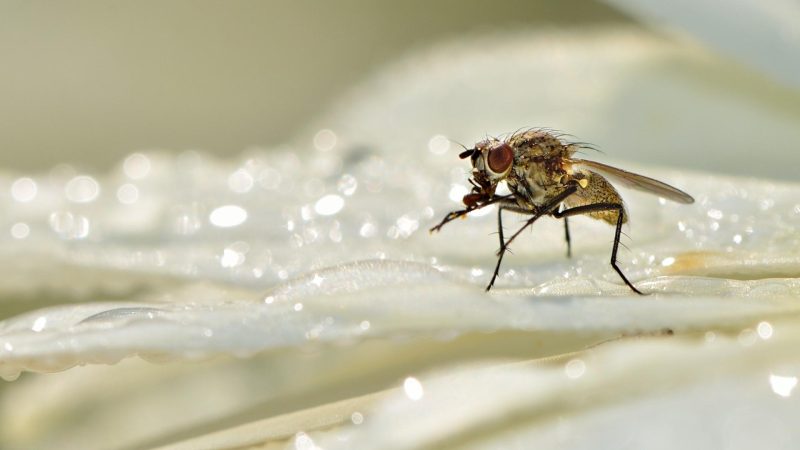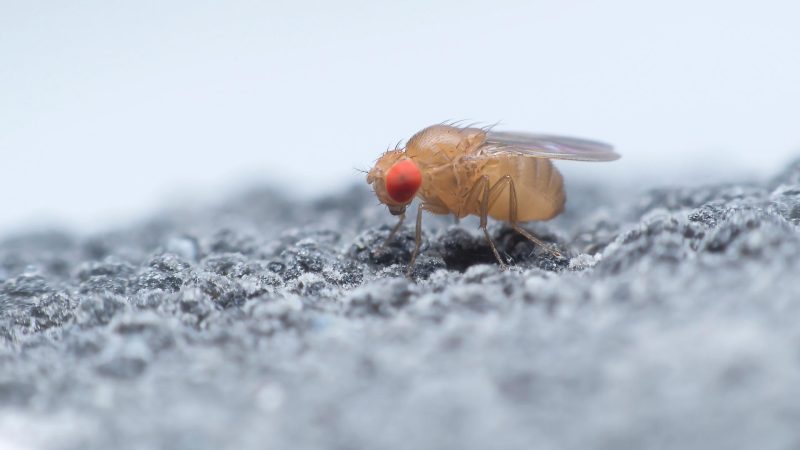When you see insects swarming on the fermenting fruits and decaying organic materials found in your trash, you may easily conclude that those are fruit flies. But there are other insect species that like to infest on rotten and decomposing matter and look similar to a fruit fly, which are the gnats. They are often confused with each other due to their comparable habits and appearances.
What’s the difference between fruit flies and gnats? Fruit flies belong to the Tephritidae and Drosophilidae family of the order Diptera, while gnats originated from the suborder Nematocera, although of the same order. The former are tan to black in color with big, red eyes, brown thorax and head, and black wings while the latter have dark gray to black bodies with smaller black eyes and veiny large wings.
In this article, we’ll discuss these insects by knowing their respective life cycles, similarities, distinguishing traits, and effective remedies for trapping and getting rid of them.
What Do Fruit Flies and Gnats Look Like?

Gnats are approximately 1/8 inches in length and have dark gray to black body structures. They have black eyes that are smaller than fruit flies, while their legs and bodies are typically long and slender, just like mosquitoes. Their wings are large and veiny, but despite this, they are very weak fliers.
On the other hand, fruit flies have a size of at least 1/8 inches with tan to black bodies, brown heads, and thorax, and an abdomen with black patches. They have big, brick-red eyes which are due to the eye pigments namely xanthommatin and drosopterin. Their bodies are somewhat round, and circular similar to a housefly, and their wings are adorned with black patterns. They also have segmented antennae and dark-colored abdomens and tails.
Related: Where Do Fruit Flies Come From? | Information and Facts
The Life Cycle of Gnats and Fruit Flies
Life Cycle of Gnats

Adult gnats typically have a lifespan of seven to ten days, but during this time, they can lay 250 to 300 eggs. The said eggs may be laid singly or in groups, usually at the top of the soil that is near plants. They are hatched within four to six days at 75°F and will turn into larvae that have whitish, elongated bodies and lustrous blackheads.
These larval creatures will feed for ten to fourteen days on food, consisting of root hairs, grass clippings, leaf mold, and organic plant straws. They will then pupate in the soil, and after four to six days, an adult gnat typically emerges.
Their life cycle is completed in four weeks or seventeen days but may also depend on the degree of temperature as the said process may be hastened by warmth and heat.
Related: Eliminate Fruit Flies Forever | Proven Techniques and Tips!
Life Cycle of Fruit Flies

The female fruit flies can lay 50-75 eggs in a day and up to 500 eggs in ten days on the surfaces of decaying fruits and vegetables. These eggs have a thin but strong protective sheet known as a chorion that has two stalks protruding anteriorly.
Then, it is hatched into a larva that appears like a white, segmented worm that has black mouthparts in the head. These larvae typically shed their skin at least two times and feed on fungi and yeast found on the infested organic material.
When these larval creatures are ready to pupate, they will leave their present habitat for dryer places. The pupal stage may last for six days, and a pupa case will be formed from its larval skin. They usually begin to mature during this stage, and their bright, red eyes and black wings become noticeable from their pupal case within 24 hours of their adult transformation.
Fruit Flies and Gnats’ Habitat

Fruit flies reside in areas where there are decaying fruits and vegetables as well as fermenting food and beverages. This includes the kitchen, restaurant, cafeterias, hotels, and other food service centers.
It may also be found in places where fruits and vegetables are prevalent, such as orchards, fruit plant yards, truck crop estates, and vineyards. Also, food processing establishments like canneries, pickled plant processors, wineries, and dehydrators can be a site of fruit fly infestation.
On the other hand, gnats are common in moist soil, plants, and areas where damp organic materials, plant remnants, and compost piles are typically seen. They can also be found feeding on the roots of plants such as Eastern lilies, clovers, pepper, poinsettias, cucumbers, carnations, soybeans, corn, potatoes, and lettuce.
Where Do Fruit Flies and Gnats Come From?
The majority of the time, houses with overripe fruits or vegetables will harbor fruit flies. Adults can infiltrate your house by flying in via open windows, screens with holes, or fruit from the shop that has been contaminated. Everything that is sticky and delicious will draw fruit flies. This indicates that even if you get rid of ripe vegetables, they could locate another supply, like your open garbage can.
On the other hand, since gnats are drawn to moisture, an infestation can quickly spread if they discover a consistent supply of moisture, such as a kitchen drain, dirt, or an open trash can.
What Causes a Fruit Fly or Gnat Infestation?
The aromas of ripening fruit, organic debris in your drains or open garbage cans can attract fruit flies and gnats, which are small enough to enter your home. Then, they can swiftly mate and produce hundreds of young ones, resulting in an infestation.
Are Gnats and Fruit Flies the Same?
Gnats and fruit flies belong to the same order (Diptera) and class (Insecta), but they are generally not the same. The latter came from the Drosophilidae family, while the former originated from the suborder Nematocera, which includes the families of Mycetophilidae, Anisopodidae, and Sciaridae.
What Are the Distinct Similarities Between Gnats and Fruit Flies?
It may be normal to mistake gnats for fruit flies due to the somewhat identical appearances of their wings, head, and thorax. But aside from their similar looks, they also belong to the same order and class.
Both of them have a fascination for decomposing organic materials, decaying fruits and vegetables, and wastes. So, you would typically find them in places where these things are present. Lastly, they both can cause diseases and be nuisances in homes.
Fungus Gnats vs. Fruit Flies
Appearance:
Adult fungus gnats are typically 1/16 to 1/8 inches in length with dark gray to black body parts. They have long legs similar to a mosquito with segmented antennae that are lengthier than their heads.
On the other hand, fruit flies also measure 1/8 inches in length with tan to black body structures, brown thorax and heads, and brick-red eyes. They look similar to a housefly due to their round and ovular body shape.
Habitat:
Fungus gnats live in moist and damp places such as the water-filled soil of potted plants. However, they can also reside in areas where decomposing matter. Rotten organic materials are found as the adult and larval species of these insects feed on these resources.
On the other hand, fruit flies swarm around fermenting and overripe fruits and vegetables that are found in kitchens or store shelves. They can also live in garbage bins, trash bags, empty beverage cans, and mop buckets.
Behavior:
Gnats may be seen flying individually or in small groups around decomposing matter and rotten organic materials. On the other hand, a fruit fly usually hovers in big groups and likes to swarm around rotten and overripe fruits, vegetables, drinks, and other food items.
Things that attract them:
Fruit flies are enticed by decaying and fermenting fruits, food, and drinks. On the other hand, fungus gnats are tempted by decomposing food supplies, overripe produce, moist soil, overwatered plant pots, and meal spillage.
Where they lay eggs:
Fungus gnats breed and lay their eggs on top of rotten organic materials, moist soil, and damp places. On the other hand, fruit flies usually give birth on the surfaces of fermenting fruits and vegetables.
How they can enter a house:
Fruit flies can enter your home when the eggs embedded in the fruits and vegetables are found in your kitchen or pantry. On the other hand, gnats can be introduced inside a house through a potted plant.
Spreading bacteria:
Fruit flies cause bacterial infections by contaminating the food, while gnats typically do it by biting.
How to Get Rid of Fruit Flies and Gnats?
The following are the effective strategies for getting rid of fruit flies and gnats:
1. Clean your surroundings.
Fruit flies and gnats love to fly around unkempt garbage bags, disposal bins, and organic materials that are open for infestation. To prevent this occurrence, regularly clean the places of your house where these insects might stay, such as dirty kitchen counters, waste containers, house drains, and fruit pastries. You can use cleaning solutions or bleach to sanitize the surfaces of these areas.
2. Dispose of decaying and overripe fruits and produce.
These insects are attracted to fermenting and rotten vegetation. So when these food items are left to rot on kitchen tables or food shelves, there is a big chance that these pests will devour and infest them. When throwing it away, put it in closed bags or receptacles to prevent fruit flies and gnats from entering.
3. Use insect traps.
Homemade traps can be effective in getting rid of fruit flies and gnats. This can be done by utilizing simple materials like apple cider vinegar, dishwashing soap, beer, or wine.
You can put any of them in a glass container with or without dish soap. Then, cover it with plastic wrap. The said cover must be poked with small holes, which will serve as the entry points of insect pests. Once they go inside the containers, they will have difficulty going out of it.
4. Apply natural insect sprays.
Fruit flies and gnats can be deterred through the application of natural plant sprays. This can be done by using the extracts or essential oils of herbs like lemongrass, lavender, basil, peppermint, eucalyptus, mint, garlic, rosemary, tea tree, and cinnamon. You can also utilize other home ingredients such as vinegar and bleach solution.
5. Do not overwater plants and drain containers with unused water.
Gnats thrive in moist and damp environments. So when potted plants are filled with so much water, these insects will surely reside on them.
Also, your house may be surrounded by open bottles and containers that contain stagnant water. This must be drained as it can be a potential breeding site for various insect pests.
Related: How to Get Rid of Fruit Flies for Good? | Tips and Guide
Will Fruit Fly Traps Work for Gnats?
In most cases, fruit fly traps also work for gnats. This means that the latter can also be captured using traps made for flies.
Good examples include the use of a glass container filled with apple cider vinegar and dishwashing soap or wine and covering it with plastic wrap poked with holes. These insects will go inside the said holes, and it will be hard for them to exit from them.
You can also use commercial fly traps and glue boards that can instantly catch insect pests. These are widely available in local stores, hardware, and online shops.
Related: How to Get Rid of Gnats in House? | 9 Effective Ways
How to Prevent Fruit Flies and Gnats?
Remember that humid or moist surroundings are ideal for housefly reproduction. Use non-chlorine bleach to clean these spots, and take the necessary precautions to stop moisture buildup in the future.
Maintain tight seals on your doors and windows. Ensure that the window has a screen to prevent flies from entering if you wish to open the window to allow the air in.
Bananas, onions, tomatoes, and potatoes are examples of ripening produce that should not be left out. So you should store them in the refrigerator until the issue is remedied. Keep in mind that fruit flies also enjoy alcoholic beverages and other sugary beverages. So avoid leaving open wine bottles and juice goods.
Can You Get Rid of Fruit Flies and Gnats the Same Way?
Because fungus gnats and fruit flies multiply quickly, it’s critical to take action right away. Fruit flies can transmit illnesses through tainted food in addition to being bothersome, and home plants can suffer root damage from gnats. Because these two pests present different problems for your house, controlling them calls for various techniques.
When you arrive home, wash your produce if you have fruit flies, and put your fruits and veggies in the refrigerator. If there are any spills in or around your kitchen trash can, wipe them up right away. When you take away their supplies of food and water, they’ll often leave and look for a new place to live.
Check the soil and roots of your indoor plants, especially if there are gnats in the house. To eliminate any chance of eggs hatching, it might be helpful to replace your potting soil. Do not overwater your plants, and make sure that any extra water can be quickly drained from the pots. Because cinnamon functions as a natural fungicide and deters pests, adding it to your soil can also help avoid infestations.
List of Sources
Fruit Flies. Oklahoma State University.
Potter, M. F. (1994). Fruit Flies. University of Kentucky.
Bethke, J. A., Dreistadt, S. H. (2013). Fungus Gnats. University of California Agriculture & Natural Resources.
Fungus Gnats. Oklahoma State University.
- How to Get Rid of Copperheads | Practical Guide - August 27, 2023
- How to Get Rid of Corn Snakes | What Makes Them Aggressive? - August 27, 2023
- How to Get Rid of Alligators | Safety Measures and Removal Methods - July 16, 2023

